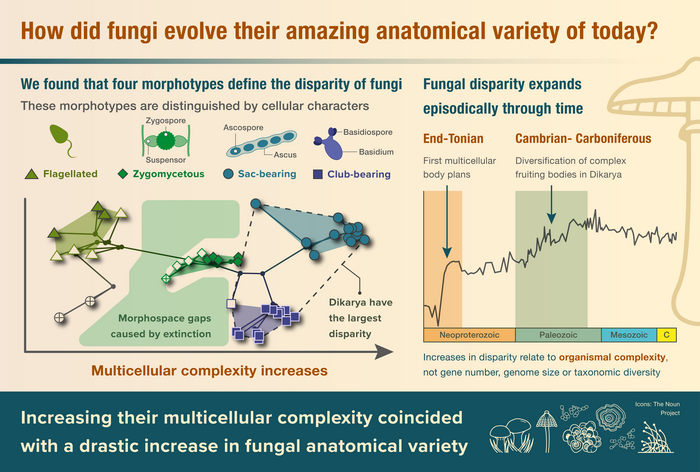Scientists at the University of Bristol have discovered that the vast anatomical variety of fungi stems from evolutionary increases in multicellular complexity.

Credit: Thomas Smith
Scientists at the University of Bristol have discovered that the vast anatomical variety of fungi stems from evolutionary increases in multicellular complexity.
Most people recognise that fungi come in an assortment of shapes and sizes. However, these differences, often referred to as the disparity of a group, had never been analysed collectively.
Researcher Thomas Smith, who conducted the study while at Bristol’s School of Earth Sciences, explained: “Prior to our analyses, we didn’t know how this variety was distributed across the different types of fungi. Which groups are the most varied when considering all parts of the fungal body plan? Which are the least? How has this variety accumulated and diminished through time? What has shaped these patterns in disparity? These are the questions we sought to answer.”
What they found was that fungal disparity has evolved episodically through time, and that the evolution of multicellularity in different fungi appears to open the door for greater morphological variety. They saw increases in disparity associated with both the emergence of the first multicellular fungi, and then the evolution of complex fruiting bodies such as mushrooms and saddles in dikaryotic species. These fungi are defined by the inclusion of a dikaryon, a cell with two separate nuclei, in their life cycles.
The main implication is that these results align with those of analyses of animal disparity. Both kingdoms present clumpy distributions of anatomical variety which have evolved intermittently through time.
Mr Smith said: “The world of fungi is defined by bright colours, strange shapes, and stranger anatomies. Our analyses demonstrate that this breath-taking anatomical variety has evolved in bursts, driven by evolutionary increases in multicellular complexity.”
The next step is to combine the datasets characterising the disparity of these two kingdoms and keep expanding the taxonomic net, starting with plants and algae. Nevertheless, this fungal dataset brings the team one step closer to characterising, visualising, and analysing the disparity of all multicellular life.
Paper:
‘Evolution of fungal phenotypic disparity’ by Thomas Smith and Professor Philip Donoghue in Nature Ecology and Evolution paper.
Journal
Nature Ecology & Evolution
Method of Research
Computational simulation/modeling
Subject of Research
Cells
Article Title
Evolution of fungal phenotypic disparity
Article Publication Date
15-Aug-2022




